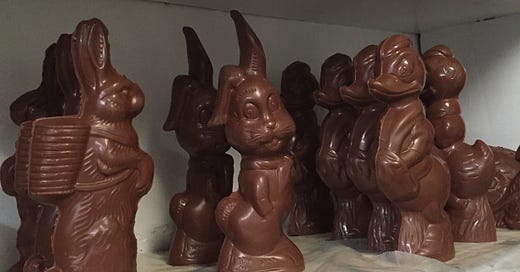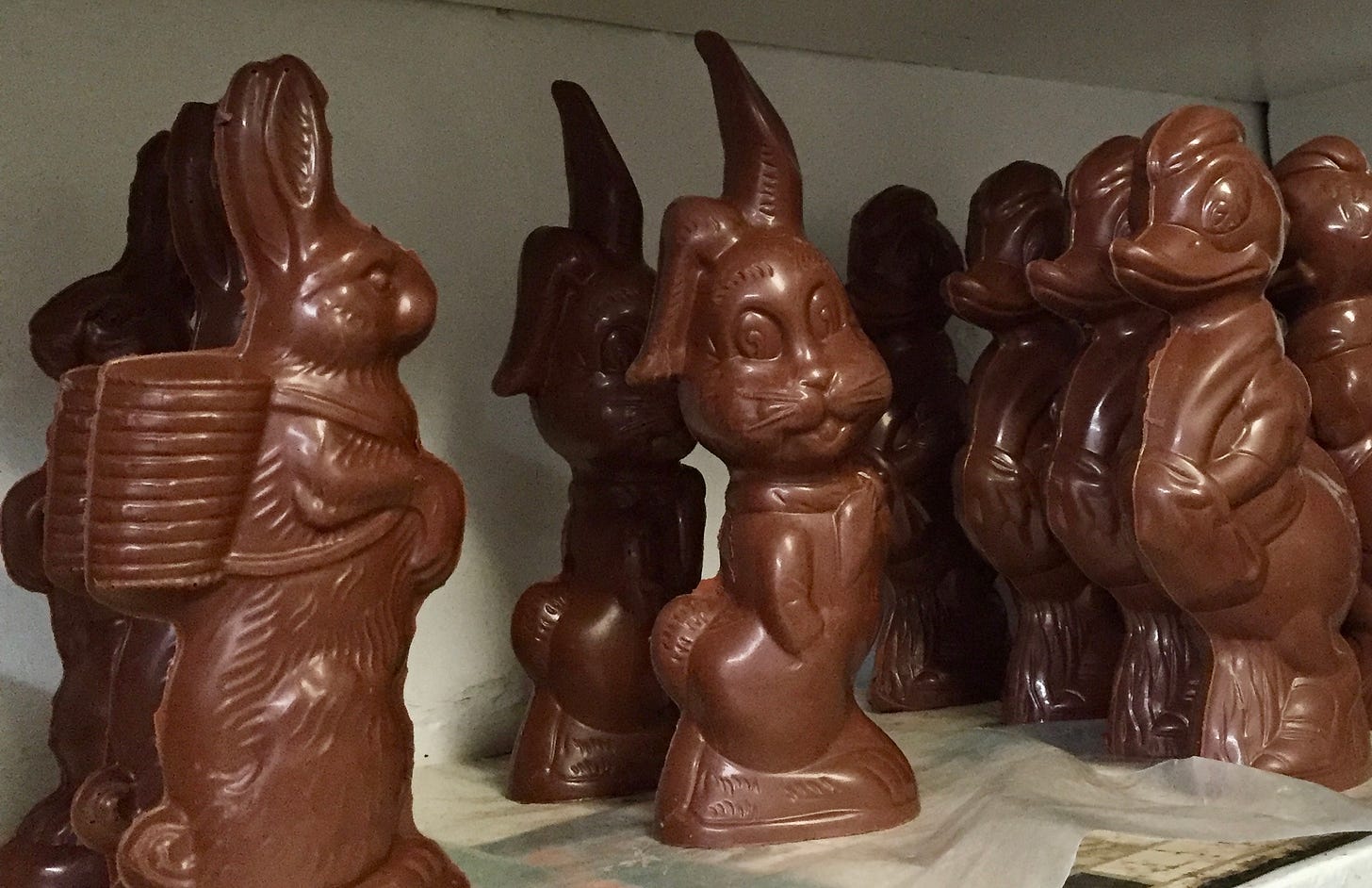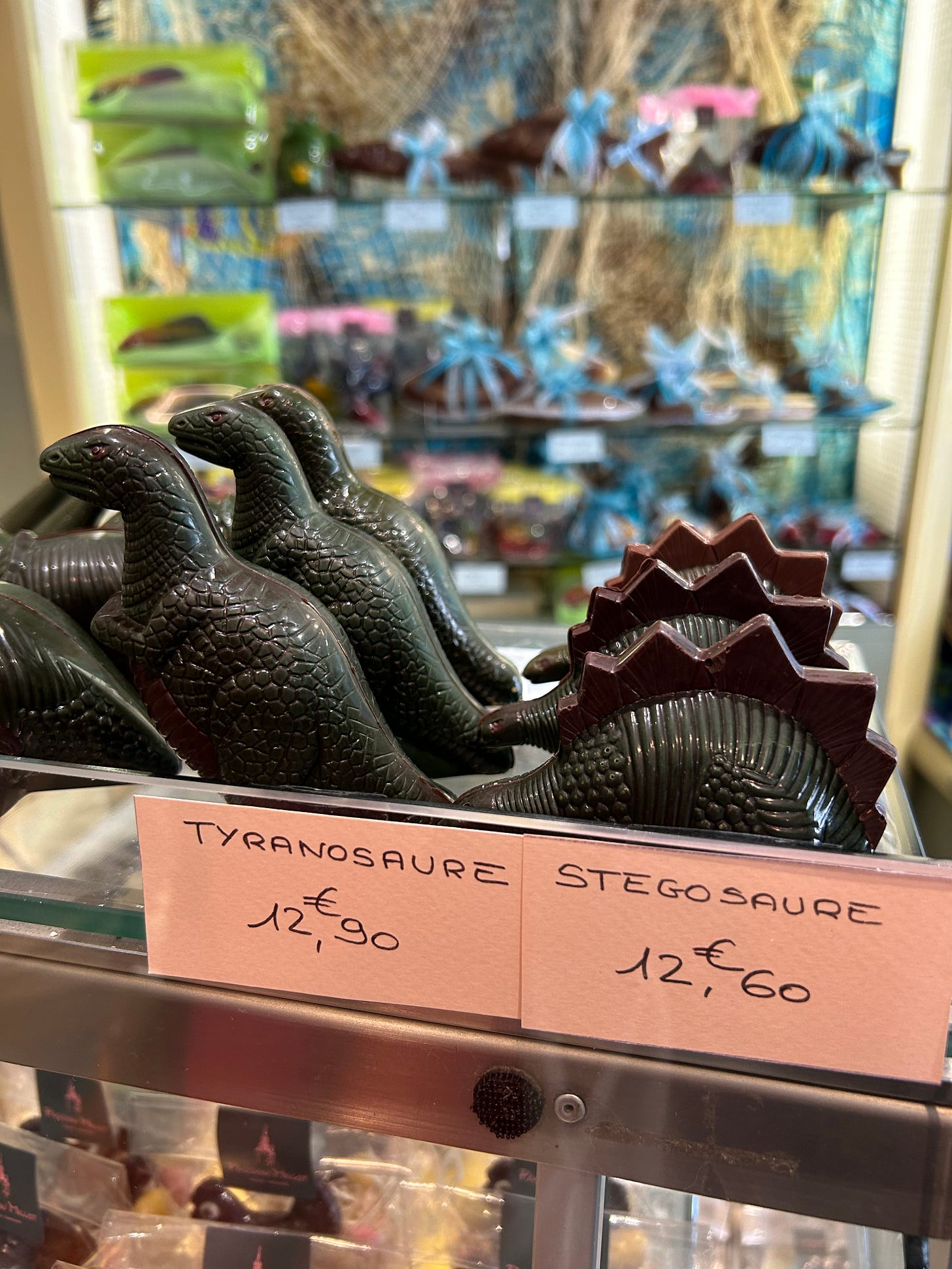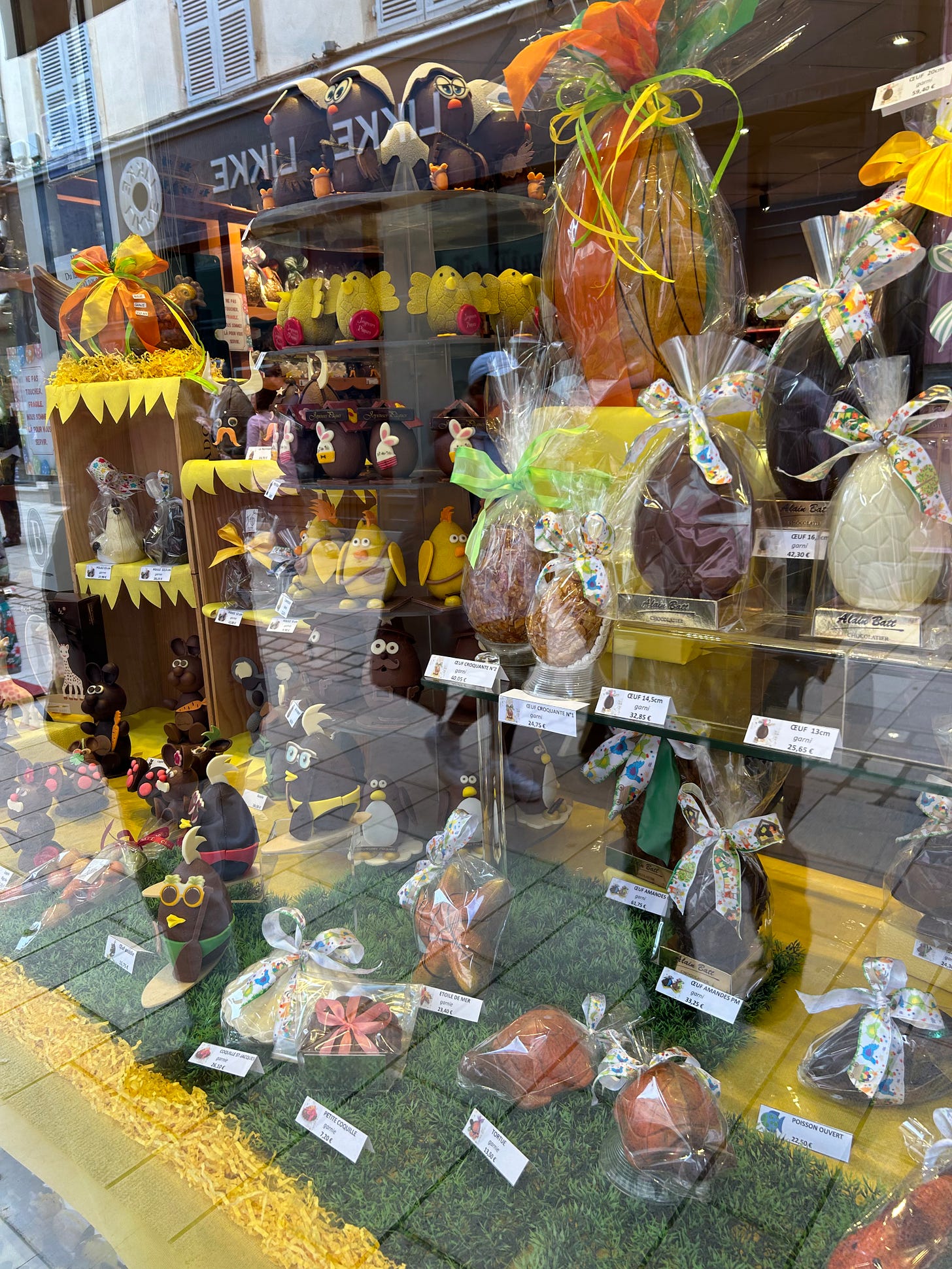I’m in France as I type this, on my way back from three weeks of eating and drinking myself into a tizzy. While here I’ve admired plenty of chocolateries and their fabulous Easter window displays of chocolate figurines ranging from the classic chickens, eggs and bunnies, to the less classic dinosaurs and fish. In Montreal you won’t find many church bells or fish, but in France fish are traditionally given for April Fool’s Day, Poisson d’Avril.
My favourite was probably the Bernachon chocolaterie in Lyon where, surrounded by chocolate rabbits, eggs, fish and bells in all shapes and sizes, the sweet smell was intoxicating. If it hadn't been for all the chic salesladies buzzing around me, I would have reached out, grabbed hold of the nearest bunny and devoured it whole.
The visit brought back memories of the time in 1990 several years ago, when I worked in the chocolate department of the sadly gone Pâtisserie de Gascogne where we handled everything chocolate for the four Gascogne shops in the Montreal area.
I was one of three chocolatiers who churned out thousands of chocolate bonbons, truffles, decorations, marzipan animals and moulded figurines. But my most vivid memories are of the Easter season, when the entire department was whipped into a frenzy of activity to fulfill all those chocolate dreams.
The day after Valentine's was when the bunny blitz began. Out came the various moulds, old and new, some still covered in last year's chocolate. The excitement mounted as the three of us polished the insides of the molds with cotton, anticipating all the beautiful things to come. The large slabs of chocolate from the French company Cacao Barry started arriving by the truckload. Goody goody!
Once the excitement abated, however, the work turned from fun to frustrating. Chocolate is tricky to work with and often seems to have a mind of its own.
Most chocolate pieces are moulded three times: the first coat is applied with a paint brush then the mould is clipped together and then two successive coats of chocolate are poured inside. Mould the chocolate when it’s too cold and your rabbit comes out too thick. Mould the chocolate when it’s too warm and your rabbit doesn't come out of the mould at all! Chocolate figurines are sold by weight and any one that’s either too light or too heavy gets tossed back into the vat of warm chocolate.
The moulds weren’t all that cooperative either. We had names for every one: smiling rabbit, buck-toothed rabbit, sitting rabbit, rabbit with basket, angry rabbit, lady rabbit, boy rabbit, rabbit in sports car etc. Most were made of thin plastic or polycarbonate. The best were the older ones made of metal, including a German mould of a duck with a wheelbarrow that was my absolute favourite. When properly polished, that mould would turn out ducks that emerged with sheen on them comparable to Jennifer Lopez’s skin.
Then there were the others. I remember one rabbit we could never unmould without it losing its head. (At Christmas time we would make a whole chocolate manger and the Joseph figurine always lost its head too). Some of the larger rabbits would unmould beautifully only to crack and disintegrate as they warmed to room temperature. But when they turned out perfectly, you couldn't help but stop to admire your work, handling the figures with great care and, preferably, rubber gloves (to avoid fingerprints).
When you spend eight hours a day making chocolate rabbits, your mind begins to play tricks on you. By the end of the season, I started to have recurring nightmares about huge chocolate rabbits chasing me, chocolate statuettes sticking to the inside of the mould (the worst!), and even of being moulded in chocolate myself.
For weeks, my hands and clothes reeked of chocolate. All the skin around my chocolate-stained fingernails started to peel off because the chocolate was so acidic. The smell often made me nauseous. Despite all that, I never lost my taste for chocolate. In fact, I developed a stronger taste for milk chocolate. I'd snap the ears off the broken rabbits and scarf them back when the chef wasn't looking.
Unlike the commercial, machine-moulded eggs and rabbits, chocolate figurines sold in pastry shops are either made on site or purchased from a bulk chocolate maker. We only made the white and milk chocolate figurines as all of the dark chocolate rabbits were outsourced. And when those rabbits were delivered to be packaged, we were drowning in them. I walked into a storage room one morning, turned on the light and there, standing in front of me were three, five-foot tall rabbits that scared the bejesus out of me. Not the best way to start off your day!
Although there are many enthusiastic chocolate lovers who attempt this work in their home kitchens, I would recommend it be left to the professionals. To mould chocolate properly, you have to start with large quantities of the stuff, which can be very expensive for the retail customer. By the end of the easter season at Pâtisserie de Gascogne, we were told we had transformed six tonnes of chocolate into close to 4,000 chocolate statuettes, with 40 different styles to choose from. That’s a lot of chocolate!
Also, chocolate must go through a complex tempering process before you can begin moulding. It isn't just a matter of pouring warm chocolate into a mold and shaking it around. Chopped semisweet chocolate is heated over a water bath until warm and completely melted, then it must be cooled to 27º C, and THEN it must be slowly reheated to no more than 31º C. It is the unstable structure of the cocoa-butter molecule that calls for all these changes in temperature.
A well-tempered, good-quality chocolate has a brilliant sheen to it, a smooth texture and an audible snap. A poor-quality chocolate will have none of these characteristics. If buying commercially made chocolate, look for cocoa butter listed as an ingredient, which is some indication of quality.
Any Easter chocolate leftovers should be kept well-wrapped in a cool dry place. Dark chocolate can be stored indefinitely, but white and milk chocolate should be consumed within six months as the milk solids can go rancid. Never keep chocolate in the refrigerator because it absorbs humidity and all surrounding smells.
And if you end up with too much chocolate in your house this Easter, keep in mind that broken Easter bunnies can be melted down and turned into a fabulous Mother's Day cake or chocolate mousse. Just remember to remove the candy eyes first.
White Chocolate Mousse
Serves 6
Keep reading with a 7-day free trial
Subscribe to Lick my Plate to keep reading this post and get 7 days of free access to the full post archives.








